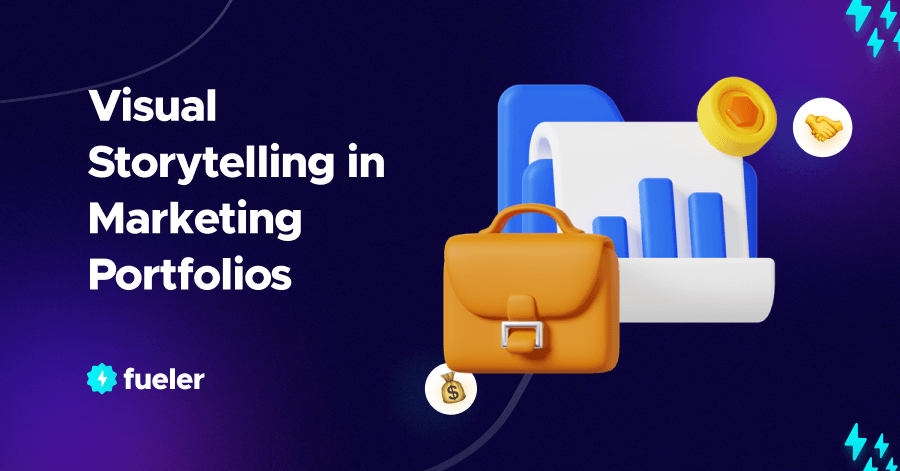Visual Storytelling in Marketing Portfolios

Riten Debnath
14 Aug, 2024

Introduction
Visual storytelling is a powerful technique that unites people on a common level and breaks down communication barriers. Using visual storytelling in your career portfolio can greatly improve your capacity to convey ideas, highlight your abilities, and make an impression on prospective clients or employers in the professional world. We'll examine the fundamentals of storytelling through images in this blog post and how you can use it in your marketing portfolio.
The Power of Visual Storytelling
Stories are at the heart of memorable marketing. They transform dry information into engaging narratives, fostering deeper connections between the audience and the message. This emotional resonance can extend to your brand, products, and services, setting you apart from the competition.
Engaging Your Audience
In marketing, visual storytelling is a powerful tool that fascinates audiences, explains difficult concepts, and encourages participation. By incorporating captivating visuals into the narrative of the "Oman Golden Visa," brands can leave a lasting impression and forge closer bonds with their target audience. This fusion of compelling storylines with striking visuals has the power to evoke emotions, making the concept of the Oman Golden Visa more relatable and memorable. It simplifies complex information, making it easier for audiences to understand and retain. Effective visual marketing, especially in promoting initiatives like the Oman Golden Visa, can grab attention and encourage audience participation.
Creating a Narrative
A compelling narrative draws audiences in, engages their emotions, and leaves a lasting impression. Here's how to craft a narrative that resonates:
First and foremost, you should understand your audience: Identify your target audience, who are you trying to reach? What are their interests, values, and challenges? Empathize with their needs and understand their desires, fears, and aspirations. Lastly, speak their language, and use a tone that resonates with your audience.
As you craft your narrative, keep your core message in mind and develop characters that the audience can identify with. Create a compelling storyline and organize your narrative with a distinct beginning, middle, and end. Include conflict and resolution, and present obstacles for your characters to conquer. Finally, but just as importantly, make emotional connections by evoking feelings through words and imagery.
Key Visual Elements to Include
To make your storytelling impactful and compelling you should include key visual elements.
High-Quality Images
To make an impact that lasts, high-quality pictures and digital storytelling for marketers are necessary. Businesses may establish a strong connection with their target market and increase brand recognition and engagement by integrating interactive experiences and striking images. Whether you are using virtual reality to take viewers on a journey or using detailed imagery to showcase products, strategic use may take your marketing efforts to new levels. In addition to traditional photography, many marketers now generate AI images for free to create unique visuals that complement their stories.
Here are images featuring some key visual elements in marketing to include in your storytelling:
- A professional headshot of yourself or your team.
- A well-composed photo of your product or service in use.
- A visually appealing image that captures the essence of your brand.
Infographics and Data Visualization
Infographics and data visualization are powerful tools for transforming complex data into engaging and easily digestible visual stories. By using charts, graphs, and illustrations, you can simplify complex information, highlight key trends, and make your content more shareable. When combined with compelling storytelling, these visual elements can captivate your audience, making your message memorable and impactful.
Videos and Animation
Dynamic tools like animations and videos enhance visual storytelling in marketing. These formats, blending sound, vision, and motion, present an excellent opportunity to connect with viewers more deeply. By incorporating cutting-edge tools like an AI animation generator, you can transform your marketing approach. Simply prompt your video idea, and the AI will handle the rest: writing the script, generating visuals, adding voiceovers, subtitles, and more.
With this technology, creating engaging content such as explainer videos, behind-the-scenes peeks, or imaginative animated stories becomes effortless. These emotionally compelling stories can turn complex information into relatable narratives, strengthening your marketing strategy and elevating audience engagement.
Designing a Visually Appealing Portfolio
A visually appealing portfolio is crucial for showing off your skills and attracting potential clients. Here are key elements to highly consider while constructing your portfolio:
1. Consistent Branding
Consistent branding is crucial for creating a visually appealing portfolio that reflects your personal style and professional identity. By maintaining a cohesive color palette, typography, and visual language throughout your portfolio, you can establish a strong brand presence and leave a lasting impression on potential clients or employers. This visual consistency enhances your portfolio's aesthetic appeal and reinforces your brand message and values.
2. User-Friendly Layout
A positive user experience is contingent upon having a user-friendly layout. You can make sure that users can quickly locate the information they need by giving priority to access content, simple navigation, and an intuitive design. Not only can a well-structured layout improve usability, but it also presents a clean and professional image. You may make a website or application that is both useful and aesthetically pleasing by concentrating on the requirements and expectations of the user.
3. Interactive Elements
Interactive elements can bring your portfolio to life and engage your audience. By incorporating interactive features such as clickable links, animations, videos, and quizzes, you can create a more dynamic and engaging experience for your viewers. This can help you to showcase your skills and personality uniquely and memorably.
Here are some tips for using interactive elements:
• Choose interactive elements that are relevant to your work.
• Make sure your interactive elements are easy to use and navigate.
• Test your interactive elements on different devices and browsers to ensure compatibility.
• Use interactive elements to tell a story about your work.
Tools and Resources for Visual Storytelling
To stay competitive in today's visually-driven market, visual content for marketers is key. These tools can boost the output of your in-house or freelance creative teams.
1. Graphic Design Software
Graphic design is an essential tool for creating visually appealing and engaging content. There are many different types of graphic design software available, each with its strengths and weaknesses.
Portfolio design tips:
- Some of the most popular graphic design software programs include Adobe Illustrator, Adobe Photoshop, Sketch, Figma, and InVision.
- Optimize for Mobile: With the increasing number of people browsing the web on their smartphones, it's crucial to ensure your portfolio is mobile-friendly. Your design should adapt seamlessly to different screen sizes without compromising the visual appeal or user experience.
2. Stock Photo and Video Resources
Strong visual content is necessary to tell a tale that engages the audience. Fortunately, you may assist your creative pursuits with an abundance of stock photo and video resources. Large collections of beautiful, free photographs may be found on websites like Unsplash, Pexels, and Pixabay. Think about Shutterstock, Getty Images, or Adobe Stock for high-quality stock photography. You can use these photos for your graphic design in portfolios and select the ideal videos to enhance your narrative by offering a wide variety of graphics.
3. Infographic and Data Visualization Tools
Infographics and data visualization tools are essential for creating engaging and informative content, especially when promoting initiatives like the "Saudi Golden Visa." These tools can help you communicate complex information clearly and concisely. Here are some of the most popular infographic and data visualization tools:
- Tableau: A powerful data visualization tool that can be used to create interactive dashboards and reports, ideal for showcasing the benefits of the Saudi Golden Visa.
- DesignWiz: It is a user-friendly online flyer maker platform that empowers businesses, individuals, and content creators to create professional-quality marketing flyers effortlessly.
- Qlik: A data discovery platform that allows users to explore data and find insights, making it easier to present the impact and opportunities of the Saudi Golden Visa.
- Google Charts: A free and easy-to-use tool for creating charts and graphs that can visually represent key data points related to the Saudi Golden Visa.
- Infogram: A user-friendly tool for creating infographics and other visual content, perfect for illustrating the advantages of the Saudi Golden Visa.
- Canva: A versatile design tool that can be used to create infographics, presentations, and social media graphics, helping to visually convey the significance of the Saudi Golden Visa.
Case Studies of Successful Visual Portfolios
Visual storytelling in marketing has become a powerful tool for businesses and individuals alike.
Let's explore some successful examples of enhancing portfolios with visuals across different industries:
Apple's Visual Portfolio: Minimalism and Innovation
Apple has perfected the art of minimalist design in its portfolio. Their focus on clean lines, whitespace, and high-quality imagery creates a sense of elegance and sophistication. The company's portfolio effectively conveys its brand identity as innovative, user-centric, and premium. By emphasizing product simplicity and functionality, Apple's storytelling through images resonates with consumers seeking sleek and intuitive designs.
Gucci's Visual Portfolio: Luxury and Opulence
Gucci's portfolio is a masterclass in creating a luxurious and aspirational brand image. Their use of rich colors, intricate patterns, and high-fashion imagery evokes a sense of luxury and exclusivity. The brand consistently delivers visually stunning campaigns that resonate with its target audience of affluent consumers. Gucci's ability to blend tradition with contemporary trends is evident in its portfolio, making it a benchmark for luxury fashion brands.
Conclusion
Effective visual storytelling in marketing is essential in today's visually-driven environment. You can tell an engaging story that connects with your audience by adding interactive elements, videos, infographics, and high-quality photos to your portfolio. Keep in mind that the goal of a well-designed portfolio is to elicit an emotional response from your audience, not just to display your work.
Fueler is a career portfolio platform that helps companies find the best talents for their organization based on their proof of work.
You can create your portfolio on Fueler, thousands of freelancers around the use Fueler to create their professional-looking portfolios and become financially independent. Discover inspiration for your portfolio
Sign up for free on Fueler or get in touch to learn more.


